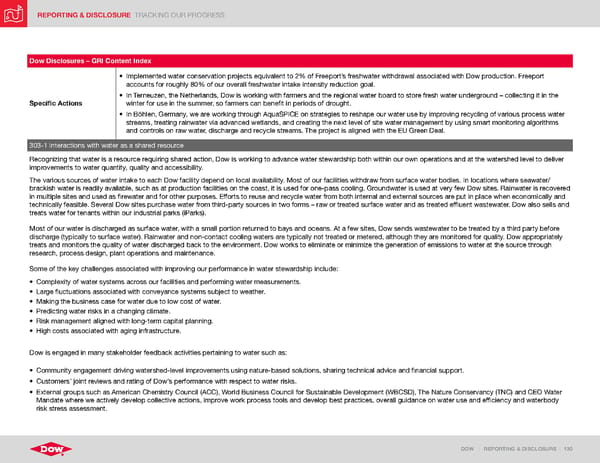REPORTING & DISCLOSURE TRACKING OUR PROGRESS DOW | REPORTING & DISCLOSURE | 130 Dow Disclosures – GRI Content Index Specific Actions • Implemented water conservation projects equivalent to 2% of Freeport’s freshwater withdrawal associated with Dow production. Freeport accounts for roughly 80% of our overall freshwater intake intensity reduction goal. • In Terneuzen, the Netherlands, Dow is working with farmers and the regional water board to store fresh water underground – collecting it in the winter for use in the summer, so farmers can benefit in periods of drought. • In Böhlen, Germany, we are working through AquaSPICE on strategies to reshape our water use by improving recycling of various process water streams, treating rainwater via advanced wetlands, and creating the next level of site water management by using smart monitoring algorithms and controls on raw water, discharge and recycle streams. The project is aligned with the EU Green Deal. 303-1 Interactions with water as a shared resource Recognizing that water is a resource requiring shared action, Dow is working to advance water stewardship both within our own operations and at the watershed level to deliver improvements to water quantity, quality and accessibility. The various sources of water intake to each Dow facility depend on local availability. Most of our facilities withdraw from surface water bodies. In locations where seawater/ brackish water is readily available, such as at production facilities on the coast, it is used for one-pass cooling. Groundwater is used at very few Dow sites. Rainwater is recovered in multiple sites and used as firewater and for other purposes. Efforts to reuse and recycle water from both internal and external sources are put in place when economically and technically feasible. Several Dow sites purchase water from third-party sources in two forms – raw or treated surface water and as treated effluent wastewater. Dow also sells and treats water for tenants within our industrial parks (iParks). Most of our water is discharged as surface water, with a small portion returned to bays and oceans. At a few sites, Dow sends wastewater to be treated by a third party before discharge (typically to surface water). Rainwater and non-contact cooling waters are typically not treated or metered, although they are monitored for quality. Dow appropriately treats and monitors the quality of water discharged back to the environment. Dow works to eliminate or minimize the generation of emissions to water at the source through research, process design, plant operations and maintenance. Some of the key challenges associated with improving our performance in water stewardship include: • Complexity of water systems across our facilities and performing water measurements. • Large fluctuations associated with conveyance systems subject to weather. • Making the business case for water due to low cost of water. • Predicting water risks in a changing climate. • Risk management aligned with long-term capital planning. • High costs associated with aging infrastructure. Dow is engaged in many stakeholder feedback activities pertaining to water such as: • Community engagement driving watershed-level improvements using nature-based solutions, sharing technical advice and financial support. • Customers’ joint reviews and rating of Dow’s performance with respect to water risks. • External groups such as American Chemistry Council (ACC), World Business Council for Sustainable Development (WBCSD), The Nature Conservancy (TNC) and CEO Water Mandate where we actively develop collective actions, improve work process tools and develop best practices, overall guidance on water use and efficiency and waterbody risk stress assessment.
 ESG Report | Dow Page 129 Page 131
ESG Report | Dow Page 129 Page 131